Sector experience
Investment banking, finance and private equity, technology, real estate, telecommunications, mining and natural resources, corporate and retail.
Career background
Prior to moving home to Vancouver and joining Peak, I spent 15 years in Asia, most recently as Head of Corporate Communications for Barclays, Asia Pacific. I started my career initially as a financial correspondent, before moving into banking, first on the trading desk at HSBC, and then joining what was then Barclays Capital in 2008.
Education
Bachelor of Arts (B.A.), Political Science and Government from Simon Fraser University
Career highlight
Joining Barclays only weeks after its purchase of Lehman Bros at the height of the Global Financial Crisis, and working to promote the firm as it was expanding its footprint of the business across Asia.
Favourite part of Peak life
The diversity. After 15 years working in finance it’s fantastic to work with such a wide array of clients from such different industries.
Favourite social media site
Twitter. The democratization of information has fundamentally changed the nature of how the world understands and views itself.
Furthest flung place you’ve lived?
Tai Kok Tsui, Hong Kong
Random fact
Was recognized in PR Week’s 2015 Power Book, which names that publication’s list of the most influential PR professionals around the world.
Every brand both dreams of it and dreads it. It’s the moment the company you represent goes viral and either ‘breaks the Internet’ or just breaks down. Two weeks ago, Skittles was put in this very situation as a result of Donald Trump Junior’s tweet comparing Skittles to Syrian refugees.
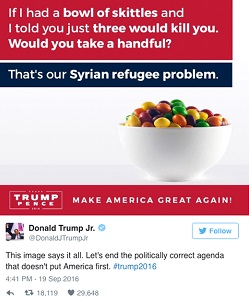
It was a Monday and 4:41 P.M. Enter stage right the on-duty social media coordinator for Skittles. Within a matter of hours, Mars’ colourful candy had become the top trending topic on Twitter. All eyes were on Skittles – my own included. What would they do, how long would it take to put together a response, get it approved internally and post it error-free under the pressure. Tweets of support flooded in as PR and social media professionals (and just generally nice people) empathized with the on-duty Skittle social media person, but the clock was ticking…
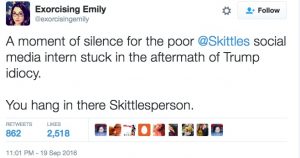
Skittles had to make a decision – and quickly.
Skittles said what?
Instead of capitalizing on the situation, Skittles smartly stepped back from the situation. Hours later, the brand’s parent company responded from their global handle with:
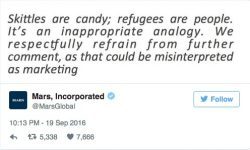
The response was short, simple, but perfect. It showed that Skittles was totally on top of taking charge of unexpected issues without turning them into reputational crises. While it can be tempting for brands to take full advantage from awkward viral situations, thinking of the bigger picture and how the story will play out is fundamental – especially when it involves politics, religion, disasters or emotive topics.
So what can brands and communicators takeaway from this?
- “Keep responses short, sweet and to the point”, Brian Bell manager brand PR, branded entertainment, and talent at Dr Pepper Snapple Group.
- Don’t overthink and complicate responses
- Avoid getting sucked into providing further commentary once you’ve released your statement
- Don’t self-promote or appear to capitalize on sensitive situations
- Emotion. Mars’ response demonstrated that they were human and not just a faceless corporate brand
Nice work Mars and social media Skittleperson!
Sector experience
Arts and Culture, Non-profit organizations, Corporate
Career background
During university, I worked with multiple student associations on diverse cultural events. After that I was at the Alliance Française of Vancouver, where I worked in a communications and events coordination capacity.
Education
BA in Languages and Literatures and MA in Multilingual Communication from the Université de Louvain, MA in General Management from the Louvain School of Management
Volunteer experience
I currently volunteer for the Canadian Public Relations Society, the Alliance Française and the YMCA on their major annual fundraising event
Favourite part of Peak life
The people and the company’s culture. No matter how stressful work might be, a touch of humour is always present!
If you were to write an autobiography, what would it be called?
The day I decided to move to the other side of the world
Career highlight
While working at the Alliance Française of Vancouver, I organized a conference about Simone de Beauvoir and the history of feminism in France. A few days before the event I received a call from CBC Radio-Canada asking if I would like to be interviewed. The next morning I was in their studio speaking about my conference for the ‘Boulevard du Pacifique’ show.
Favourite B.C. pastime
Rollerblading on the Seawall around Stanley Park
Languages
French, English, Polish, Spanish
Secret Talent
Singing terribly, I sing so badly that my friends once bought me a ‘dislike’ stamp
Furthest flung place you’ve lived?
Brussels, Galway, Madrid, Warsaw, pick your favourite!
Random fact
When I was travelling through Ireland, I met a gentleman carrying a big boar (a stuffed animal, not a real one). Marc (the boar) had his own Facebook page with pictures from all the places he has visited. I ended up on his Facebook page as a ‘boar travel companion’
As a Pole who spent most of her life in Belgium and recently arrived to Canada, I’ve always experienced communication through the multilingual lens. This unique experience was enhanced by my internship at the Alliance Française de Vancouver where we were regularly asked: ”How do I engage English and French communities?” In a city like Vancouver which is so multi-cultural, this is an issue we face more often than not – especially from a PR perspective.
Below are a few important aspects to keep in mind when creating an efficient multilingual/multicultural PR campaign.
Iceberg theory
The language is just the tip of the iceberg. We sometimes only concern ourselves with what is visible, or in this case audible; but language is built on a shared history, specific cultural norms, beliefs and behaviours. Or in the case of this metaphor, the invisible and more substantial part of the iceberg.
We don’t just speak a language; we experience it. It’s very difficult to artificially leverage a language without immersing ourselves in the context and the values that surround it.
A language grows and evolves within a culture, and this culture must be taken into account when we apply our PR campaign to another linguistic group. Doing PR in another language does not mean just duplicating the words. We have to take into account the social and cultural context of the people that the campaign is directed to.
Context and cultural background
While working at the Alliance Française, I was in responsible for organizing cultural events and promoting them to French and English speakers alike. I couldn’t simply translate a promotional campaign that was working well in French into English, the soul and purpose had to be translated as well.
One example, for the 60th anniversary of women’s right to vote in France, we decided to organize a conference about Simone de Beauvoir – a leading figure in French feminism during the second half of the 20th century. We found that the process was quite straightforward for the French speaking public, who were very familiar with the impact of Simone de Beauvoir. However, we had to take an additional step when promoting the event to the English speaking public who were less familiar with her. We explained who Simone de Beauvoir was in our English promotions and connected the event to the history of Canadian feminism, which proved more engaging.
This is a perfect example of why a PR campaign needs to be sensitive to its audience. Start by researching the subjects which are relevant to your audience. Then test your campaign materials on a native speaker to ensure that they are receiving the message about what the campaign is promoting. In the case of the Alliance Française, if we were assuming that all English speaking Canadians were as familiar with the French culture as Frenchmen are, we wouldn’t have been able to attract much of the English speaking public, had we not tailored our promotional materials to their needs.
“You’re welcome” is not “For nothing”
Most importantly, be aware of word-for-word translations. If you have ever used Google Translation, you might have noticed that it’s usually not the best tool to use if you want to be understood in another language. Translated literally, “you’re welcome” in French will result in “tu es bienvenu” which means ”you’re welcome to my house”, and if we translate ”de rien” (which is actually what we say for ”you’re welcome”) in English, it will become ”for nothing”, which is not really used in English.
It’s one of the most extreme examples, but it’s definitely not the only one, and it shows us that we must pay attention to different expressions when we pass from one language to another, as what is obvious for you isn’t always obvious for others.
Speaking another language means seeing the world differently, and our diversity is what makes us interesting!
Tags: multilingual communication
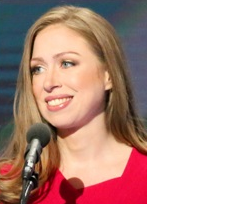
Chelsea Clinton at the National Democratic Convention 2016
Both of the Presidential candidate’s daughters spoke a week apart at the respective conventions. Both are young and attractive women and mothers. Both spoke with praise about their parents. For both it was the most important speech of their lives and in front of the biggest audience ever.
Chelsea Clinton talked of her mother’s love for service and her great skills and love as a mother and grandmother. In contrast Ivanka Trump’s speech was about her dad’s focus on his business career.
If you were reading the text of each speech, they both supported their parents and described what they are well known for. But that is not how TV works.
Back in 1964 Marshall McLuhan coined the phrase: “The Medium is the Message.” He wrote all about it in his most widely known book, Understanding Media: The Extensions of Man, published in 1964. McLuhan proposes that a medium itself, not the content it carries, should be the focus of study. McLuhan said that a medium affects the society in which it plays a role not only by the content delivered over the medium, but also by the characteristics of the medium itself.

Invanka Trump at the Republican National Convention 2016
So put the content of the speeches aside, and think back on how the ladies presented. One person had a clear advantage and expertise performing on TV. That was Ivanka Trump. She has co-hosted her dad’s national TV show “The Apprentice” and spoke with ease to the thousands in the stadium and the millions tuning in. She was confident, paused when she needed to and looked like she had made dozens of similar speeches before. She definitely has the training and like her dad she knows how to put on a show.
Chelsea Clinton, not so much. Chelsea has made speeches before, but she’s more tentative, not a commanding presence as all. While pleasant, she is not a forceful personality. Subtly, she came across as lacking confidence.
Donald Trump does not have a lot of substance in what he says, but his bombastic, argumentative and dominating presence his taken him to the top of the Republican ticket. None of his competitors work TV the way Trump does.
One of the big knocks on Hillary Clinton is that people don’t know who she is – they don’t know her; therefore they don’t trust her. Even when TV media are friendly to her, the TV medium is not.
Does the top TV performer always win? The Trumps hope so.
Fun to watch.
Donald Trump is breaking every conceivable PR101, 202 and even PR PhD rule and remains completely unaffected by it. In fact, the more he breaks the rules, the more popular he becomes. So, are those basic public relation rules that we all know outdated? His communication style is aggressive to the point of stand-up comedy; more propaganda, less public relations. But, for argument’s sake, should we throw out what we know and adopt the shoot-from-the-lip style Trump embodies – especially in the face of a crisis?
In a political nomination campaign, particularly in the United States, you can do the following, apparently without fear of law suits or reprisals:
- Attack competitors
- Call opponents liars
- Threaten to punch protestors in the face
- Be yourself – no matter what
- Make fun of the media who carry your message
Say Trump wins the election. Should you or your company adopt his style and become more aggressive in the face of attacks by the media or critics? Should you go on the offensive to try to galvanize your supporters? Should you simply thumb your nose at powerful media and treat it and your detractors with disdain?
Consider this: If “the Donald” was your CEO in a crisis and talking about your company’s critics or competitors as he is talking now about his opponents and others, how do you think it would affect your brand? I suspect his board of directors would be the first to say, “Donald, you’re fired!”
In the real world of business, you simply can’t do what “the Donald” is doing. Why? Because politics is not business reality. So, in light of Trump’s recent antics in the media spotlight, here are some lessons we can all learn:
Never attack your competitors
The first rule of good public relations is you never attack competitors. Exxon didn’t gloat publically when BP sprung a leak in the Gulf of Mexico. When Walmart parmesan cheese was found to contain cellulose recently, Safeway didn’t run attack ads about it. When you begin throwing stones it’s too easy for the media or the public to pick up some of those same rocks and toss them back at you.
Don’t call opponents liars
“The Donald” calls his opponents liars. He does this often. It’s his go-to pitch. In a heated public debate which your company may be involved in, calling opponents liars will galvanize opposition and lose you public support. When you lose your cool, you lose – period. The best strategy is to stick to your facts day in and day out and to let your facts ultimately win the day. Keep a level-head because the more nasty and out of control your opponents get, the more support you will get.
Don’t threaten to punch protestors in the face
When asked, many a CEO might agree privately, that in certain instances they’d like to punch a protester in the face. Now imagine a big project, like B.C.’s pipelines and Site C dam proposals. Imagine a CEO saying on TV, “I’d like to punch that protestor in the face.” They’d be looking for a new career immediately and the project would be dead.
You can be your own worst enemy
In Trump’s case, this means his shoot-from-the-lip style is not a good idea in a crisis. Being yourself is actually good advice for a CEO facing a crisis, as long as being yourself means you show that you care, admit your mistakes, are truthful and outline a plan to make things right. If you are shaken by what happened, allow it to show, allow your concern to show through – be human. But, if being yourself means you go on the offensive and attack everyone in your path, then save that for the boardroom.
Media don’t like to be made fun of
The media, including social media, carry your message. Making fun of media pundits, reporters, bloggers and analysts is never a good idea. It may feel to you like you are winning but the “win” is temporary. They always get the last word. You should correct factual errors they have made, point out your positive message, and then take the high road. The public is smarter than you think. They will get your message and understand when the media is being unfair.
The bottom line?
Everyone likes to copy a winner; business schools teach investment success models such as Warren Buffett’s. But, we also laud those who break the mold and go against the establishment. Case in point? Donald Trump.
If you copy Donald Trump’s nomination strategy in your business I would say that you do so at your own peril. Right now, Donald Trump doesn’t need real answers, he just needs one-liners, of which he seems to have an endless supply. When pushed into a corner he goes on a personal attack, calls someone a liar, raises a boogeyman or mentions 9-11.
A nomination campaign is not the business world or even the real world. It is more like reality TV. There is only one measuring stick: winning, and the focus is extremely short term. There is no tomorrow.
Successful businesses have a long time horizon to consider because the public won’t forget and you don’t get to completely rebrand every four years like a political party does. Unlike a new political leader, a new CEO doesn’t make all the old negative news magically disappear.
Tags: crisis communications, donald trump, media relations, Public relations
Sector experience
Oil and Gas, Real Estate, Arts and Culture, Technology
Career background
Previously I have worked for various festivals and a museum in a communications capacity, as well as in corporate communications
Education
BA in Communications from the University of Calgary, Public Relations certificate from Simon Fraser University
Volunteer experience
I have volunteered for multiple years with UNICEF, The Calgary International Film Festival and Free the Children on its ‘We Day’ programs
Favourite part of Peak life
Definitely the people, and how open and supportive of an environment Peak is. That and bagel Wednesday!
Career highlight
Creating a speech and presentation with the VP of the Oil Company I used to work for on his keynote at a major conference. It was very exciting to see 800 people give a standing ovation at the end
Favourite B.C. pastime
Hiking, trying new restaurants and biking along the sea wall
Languages
English and French
Furthest flung place you’ve lived?
Dehra Dun, India
Random fact
I once sat next to a nun on the plane and she gave me a piece of Mother Theresa’s dress for helping her translate her documents
Out with the old, in with the new
Looking back on nearly two decades of public relations work following a 30-year career as a news reporter provides an opportunity to reflect on how PR and the media interact in 2016. The new reality for the news media is there are now fewer people employed to do what, in many cases, is much more work.
After a series of buyouts of senior people, The Vancouver Sun and The Province announced earlier this year that they are merging their newsrooms. What does this mean for PR? Less competition and fewer people to cover news.
Television news that once was confined to slots at noon, supper hour and late newscasts is now delivered 24 hours a day in back to back ‘news wheel’ formats that stretch reporters, editors and videographers to new limits.
A new media frontier
The power of the internet continues to grow, with bloggers having as much or more impact than reporters for mainstream media.
So how does this impact the ability of companies, organizations and public relations professionals to get the message out in the media?
Simply put, the media landscape may have changed dramatically but there are more opportunities and channels than ever for publicity.
Everybody is talking about Donald Trump
Love him or hate him, Trump is a publicity machine. He is getting more media attention than anyone else on earth with radio, television, newspapers and social channels featuring what seems to be a play-by-play of Trump’s latest antics in the Republican presidential candidate race.
Getting noticed still makes or breaks reputations, makes the cash register ring and brings people to the door.
And so, getting your message out with ‘earned’ media – otherwise known as public relations – is still one of the best ways to become known. Although the number of reporters may be contracting, newspapers and television are still hungry for content. The number of social channels grows every day. Trade magazines also abound and every industry is supported by at least one that’s looking for stories.
Do-it-yourself
If you can’t get the media to tell your story through positive news coverage, do it yourself. Have videos produced and tell the story of your own company, your product or your services with words and pictures that matter to your brand. Then, feature it on your website.
Do something amazing and put it on the web via Youtube, Vimeo or Instagram. Send this to everyone you know. If your story goes viral, everyone will know what you want to get across and good things can happen.
Tags: donald trump, media relations, new media, Public relations, social media
Navitas is a leading global education provider that offers an extensive range of educational services through three major Divisions to students and professionals including university programs, creative media education, professional education, English language training and settlement services.The objective of this public relations campaign was to strengthen the reputation of its two Canadian Colleges by earning positive media coverage.
the goals
- Educate existing and potential Navitas partners on the company’s mission and operations in Canada and, in turn, create wider community acceptance.
- Position Navitas and its Canadian colleges as caring education providers that help international students achieve social and academic success.
- Showcase the economic impact Navitas and its pathway programs have at a local, provincial, and national level.
- Highlight student-success stories
the campaign
Peak worked with Navitas for more than two years promoting Fraser International College in Burnaby, B.C. and the International College of Manitoba in Winnipeg, Manitoba.
The media coverage focused attention on the college’s key messages, including:
- Students studying at Navitas colleges achieve academic success
- Navitas helps students integrate into their new communities
- International students contribute to the Canadian/provincial economy
the key results
- Peak generated 91 piece of media coverage and an estimated 18,849,483 impressions for both colleges between October 2013 and January 2015
- Media coverage highlights included:
This year’s BCAMA annual marketing agency panel did not disappoint. Expert speakers from top agencies provided a strong sense of what’s to come this year and created a healthy debate around what’s really going to be some of the key drivers. There was a ton of information relayed to the hundreds of branding and communications professionals in the audience. Here are few of the highlights we took away with us.
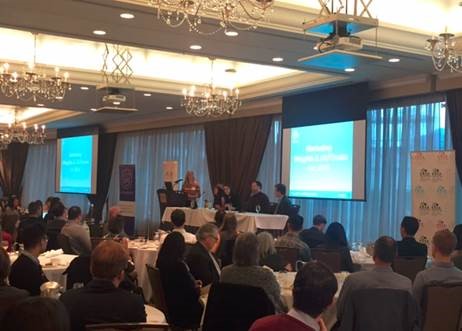
Speaker #1: Andrew McCarthy – President, Tribal Worldwide Canada
The theme of Andrew’s presentation was around using content to connect with consumers. Research has recently shown that 71% of consumers who have blocked ads have said they’d consider whitelist advertising if the content was decent. Basically, people hate bad advertising.
So, how do you increase the shareability of your content?
- Relatability – your content must be relevant
- Have a point of view – this will help streamline content and ensure it’s consistent and interesting
- Findability – search rankings are key when it comes to content dissemination
- Mobility – make sure your content is where your audience is hanging out
- Likeability – it’s an obvious one but your audience has to want to genuinely share your content
Snack Time, the milk producers of Western Canada’s cartoon series, was shared as a successful campaign where all the above was put in motion.
Speaker #2 Kelly Stephenson – Director of Strategy, Creature Agency, Seattle
Kelly’s talk centred around the prediction that there will be a rebalance between data and “creative bravery”. Kelly acknowledged the importance of data but cautioned that often marketers can get so caught up in data that the ability to connect with consumers is lost. Her argument around brands not becoming too obsessed with data was effectively summarised when she said, “data looks backwards; insights look forwards.” Marketers need to consider data and use this to create consumer insights in order to produce relevant and creative narratives that will increase the value of the relationship between brand and consumer.
An example used to highlight this argument was REI and its decision to shut up shop for the day on Black Friday and encourage its followers to #optoutside. REI chose to prioritize its shared values with its Millennial audience, putting a short-term need (a lot of revenue on Black Friday) behind the longer-term relationship. It was a smart move as the retailer generated millions of media impressions and a significant amount of content and engagement around #optoutside.
Speaker #3 April Yao – Senior Account Manager, 6S Marketing & Sheng Li Digital
April got up on stage and immediately said she had to disagree with some of Kelly’s points as 6S still uses and responds to data to ensure successful client campaigns that are closely tracked and clearly show ROI. April primarily presented on two topics: retargeting (also known as remarketing) and marketing to the Chinese population. April discussed the virtues of retargeting and dynamic remarketing (getting specific products that someone has already looked at on your brand website in front of the user when they are viewing another site). She said that, if you follow the cost per click (CPC) model, you’ll see the value quickly.
On the Chinese front, April said that approx. 20% of the Vancouver population is Chinese and encouraged the marketers in the room not to forget this growing market which often has high spending power. She talked about some of the equivalent Chinese social sites such as Youku (video), Baidu (search), and Weibo (think Twitter and micro-blogging).
April gave the example of Cirque du Soleil and how they were selling tickets fast in the English-speaking Vancouver community but not in the Chinese community. Through a Weibo contest, creating a Chinese landing page and a retargeting campaign, Cirque saw a significant increase in its ticket sales. Her final point on this community was that ethnic markets shouldn’t be forgotten but they also require their own distinct strategy.
Speaker #4 Dan Scherk – Partner & Creative Director, Traction Creative
Finally, Dan Scherk took to the stage to discuss the importance of brands adopting a user-centric approach in their marketing campaigns. He talked about how social marketing in particular has proven how brands cannot be organization-centric and that they have to prioritize user needs. Using his psychology background, he delved into social marketing behavioural theories and touched upon reasoned action approach, a benchmark for understanding and predicting human behaviour. Dan emphasised the need for marketers to tap into consumers’ beliefs, showing how that would impact attitudes which would in turn formulate intentions and lead onto certain behaviours.
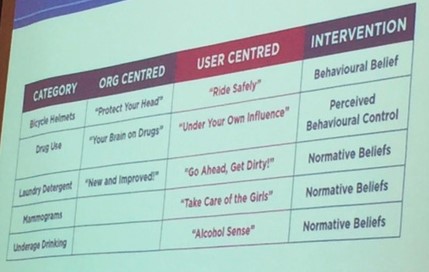 The last case study of the morning was an interesting one: it was the “Dumb Ways to Die” campaign that was launched by Metro in Melbourne, Victoria. The cartoon campaign series was focused on reducing the number of accidents on its trains. Based on this, it was extremely successful and resulted in a 20% reduction in accidents. The campaign won top industry awards and was hailed a great success by many. But it was viewed as a failure by others. Why? In the real world, the true issue was suicide. So, a successful user-centred approach would have been around suicide prevention. Instead, the brand took an organizational approach and focused on an issue that was not the real problem.
The last case study of the morning was an interesting one: it was the “Dumb Ways to Die” campaign that was launched by Metro in Melbourne, Victoria. The cartoon campaign series was focused on reducing the number of accidents on its trains. Based on this, it was extremely successful and resulted in a 20% reduction in accidents. The campaign won top industry awards and was hailed a great success by many. But it was viewed as a failure by others. Why? In the real world, the true issue was suicide. So, a successful user-centred approach would have been around suicide prevention. Instead, the brand took an organizational approach and focused on an issue that was not the real problem.
Finally, the panel moderator, Claire Booth of Lux Insights, said that, while #FOMO (fear of missing out) was a real thing last year, this year, it’s apparently going to be all about #FOLO (fear of living offline).
Tags: bcama, featured, marketing, media relations, Peak Communicators







